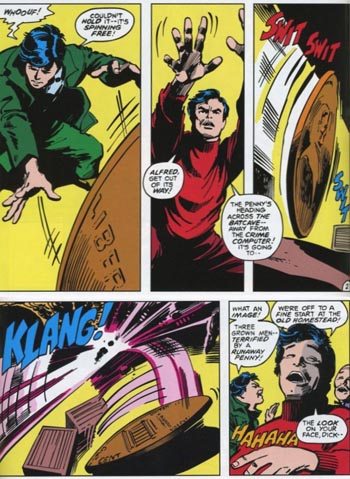A high point in the late Gene Colan’s long career was the influential work he did throughout the 1970s and early 1980s. Now DC pays tribute to that era with Tales of the Batman – Gene Colan, Volume One, which compiles the first two years’ worth of stories from Colan’s five-year run as Batman’s lead penciler, which began in 1981.
These beautifully reproduced pages showcase Colan’s natural and unexaggerated energy, consistent character modeling, and abiding mastery of atmosphere.
Through the late ‘70s, Batman’s writers had invested him with new depth that rescued his appeal and mythos from the self-parody of the ‘60s. Colan’s influence on later incarnations of Batman and Gotham City is immeasurable. The tales in this volume are all solid, entertaining superhero stories. They also demonstrate a special sensitivity toward Batman as a character. Batman grew and deepened on Colan's watch, becoming more multi-dimensional, more elusive, hinting at how grim the character would later become. In these stories, Batman/Bruce Wayne inhabits a chaotic world, rife with crime and corruption.
Colan’s covers and title pages set a moody but energetic tone. His art is fluid and deceptively simple in its design. His pages are uncluttered, focusing on key narrative elements and atmospherics. Backgrounds are detailed only when necessary. There is never a question of where to look, which keeps the stories speedy and engaging.
Gerry Conway wrote or co-wrote all but two of the stories contained in this collection. They are colorful, suspenseful, and often surprising. In an era of perfunctory comics writing, Conway was a standout, bringing a depth of character that remains convincing today. Conway excelled at weaving gritty, realistic arcs through his stories, which helped maintain a high level of plausibility amid the usual outlandish villains and supernatural elements. In this volume, ongoing plotlines pertain to a hotly-contested mayoral election, Poison Ivy’s attempt to swindle the Wayne Foundation, and the politically-motivated forced resignation of Commissioner Gordon.
The longest multi-issue story contained here has Conway and Colan reaching back to The Tomb of Dracula, as well as some of the earliest Batman comics, for inspiration. The four-part story beginning with “Blood Sport” finds Batman and Robin temporarily transformed into vampires after Robin is seduced and trapped by his would-be girlfriend Dala. She turns out to serve a character who would appear to be the Mad Monk, who first appeared in Detective Comics #31 (1939). However, due to continuity issues resulting from the stories selected for this volume, the villainous vampire’s identity is not confirmed. This type of collection, organized by artist rather than by narrative continuity, makes for occasionally frustrating reading, despite the pleasures of the individual issues. There are issues of Batman and Detective Comics not present here (i.e., not penciled by Colan) that flesh out the vampire arc. As presented here, it is full of holes, and the conclusion is sudden.
But this is a minor issue in a book crammed with creepy highlights and moody character moments: Batman searching for Kirk Langstrom/Man-Bat in the caves beneath Wayne Manor, carrying Langstrom’s young daughter on his shoulders; Dick Grayson flirting with his girlfriend on a penthouse balcony, only to glimpse an airborne plague blanketing the city below; Barbara Gordon prodding her father out of a blue funk after his forced resignation; and Poison Ivy cruelly transforming her assistant into a gigantic half-man/half-tree monstrosity.
It goes without saying that there is also a moment or two of Golden Age-tinged absurdity:
But what is most germane about this volume is its demonstration of this team’s influence. The legacy of Colan’s shadowy, noirish artwork and Conway’s economic, even poetic, phrasing are easily detected in Loeb and Sale’s The Long Halloween, and Brubaker, Rucka, and Lark’s Gotham Central. Without Colan, Conway, and the rest of this team (which includes inkers Klaus Janson and Tony DeZuniga, and colorist Adrienne Roy), we would not have had Frank Miller’s Batman – or Christopher Nolan’s, for that matter. Colan and Conway’s stories do more than just hold up well. They maintain a place of permanent excellence in Batman’s long and layered graphic genealogy.








